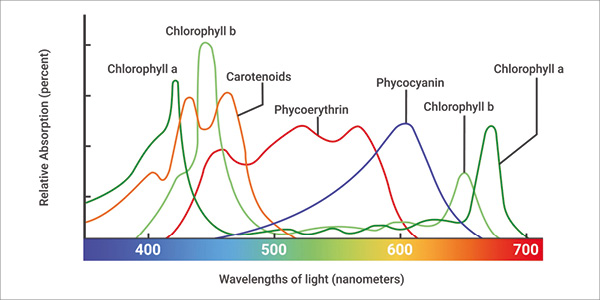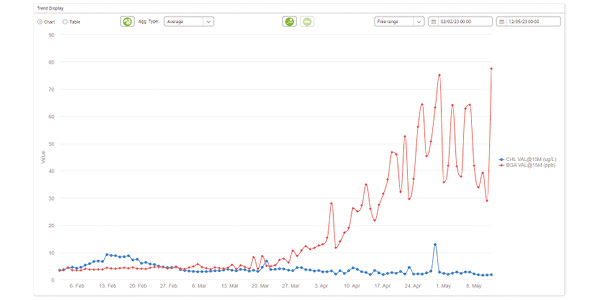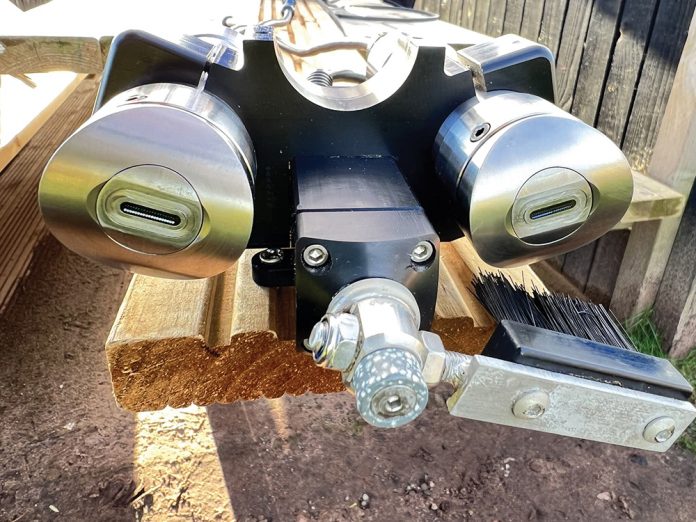Valeport Water’s Hyperion Phycocyanin and Hyperion Chlorophyll a fluorometers recently provided a solution for monitoring the levels of blue-green algae at a remote site.
In July 2022, Valeport Water was approached by a customer to provide a solution to monitor large water bodies open for public access for the presence of cyanobacteria (blue-green algae). This required near real-time access to the data which would require the sensors to be linked to a telemetry solution provided by Metasphere; the Point Orange telemetry system linked to the Palette data hosting service. The Point Orange system would also provide power to Valeport Water’s sensors.
Valeport Water’s Hyperion Phycocyanin fluorometer was paired with its Hyperion Chlorophyll a fluorometer as a check against phycocyanin false-positive readings from other plants that might be present. Both sensors were kept clean with a wiper.

Combining fluorometers to accurately measure levels of phycocyanin
Phycocyanin is an accessory pigment typically found in freshwater cyanobacteria. It “fills the gap” between the Chlorophyll absorption peaks in the blue and red band. By utilising this band, cyanobacteria benefit from increased spectral efficiency and higher growth potential that can lead to ‘Harmful Algal Blooms’.
When designing a fluorometer, once the source wavelength is determined, the emission filter’s design is key to its performance. A broadband emission filter results in a high received signal – composed of fractions from all photosynthetically active cells – both phycocyanin and chlorophyll molecules. A narrowband emission filter results in a reduced received signal, but only the fraction from the phycocyanin itself will be received – the fraction from chlorophyll molecules is not present, the optical system is now specific. Narrowband, or blue-green algal-specific, fluorometers are ideal for studying phycocyanin that’s escaped from the cell, typically because of cell lysis (breakdown of a cell caused by damage to its outer plasma membrane). Studies show harmful levels of mycrocystin toxin can be found in water when lysis occurs – a portion of the intracellular mycrocystin pool is transformed into the dissolved fraction1. Here, broadband fluorometers could give false-positives and no early warning of increasing toxin levels. Only phycocyanin-specific fluorometers, like those available from Valeport Water, give that warning.

The Trial
The system was installed in February 2023 to observe and record data background levels of chlorophyll-containing organisms before phycocyanin-containing algae appears in late spring or early summer.
The Hyperion fluorometers and Point Orange system were quickly interfaced using the Modus RTU protocol allowing standard libraries to be used extending to include remote sensor configuration changes and full control over telemetry settings.
The Point Orange telemetry system was programmed to have the fluorometers power and record data at 15-minute intervals, relaying concatenated data every 6-hours. Alarms were set to activate at predetermined phycocyanin concentrations based on WHO level 1 and 2 recommendations. Fluorometer data was cross-checked against manual sampling.
As per the data example, chlorophyll concentration (in blue) remained constant with a pronounced rise in mid-February during an unseasonably warm spell. Phycocyanin concentration rises from late March, likely due to the onset of spring.
The trial successfully showed Valeport’s Hyperion fluorometers can be successfully interfaced to, and operated with, the Point Orange telemetry system and thereby, provide real-time monitoring of remote sites. The flexibility and cost effectiveness of this solution lends itself to both temporary deployments and permanent installation.
Valeport Water designs and manufactures instrumentation for hydrological and hydrogeological investigation, drinking and surface water monitoring and for waste and industrial water industries. For more information please visit: www.valeportwater.co.uk
1 https://doi.org/10.1128/AEM .01397-20.



